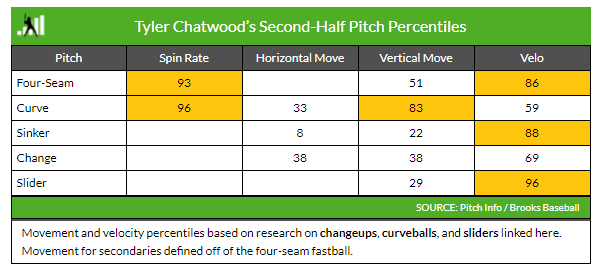When you take a look at Tyler Chatwood’s 2017 numbers, he’s quick to write off. His 4.69 ERA, 7.31 strikeouts per nine innings, and his home run/fly ball ratio of 22% doesn’t exactly scream good MLB pitcher.
But the Cubs signed the 28-year-old former Rockie to a cheap deal, three years for $40 mil, to be essentially a younger John Lackey. Nothing flashy, just a decent arm with some upside, at least on the surface that’s what you get with Chatwood.
However, if you dig deeper into Chatwood, particularly his away numbers, you start to see a pitcher that needs to get away from Coors Field. When pitching at home for the Rockies, Chatwood’s ERA ballooned to a terrible 6.01 with teams batting .299 in 2017. But, when Chatwood was on the road, his numbers dropped to a respectable 3.49 ERA with an excellent .197 opponents batting average.
Looking at his contact numbers, he was able to reduce his home 32.4% hard contact ratio down to 25.8% when on the road. He was keeping more lofted fly balls in the park on the road, fewer line drives, and even a slight uptick in groundballs. Chatwood, when on the road, was exactly the type of pitcher the Cubs covet.
Fangraph’s Eno Sarris pointed out that Chatwood’s spin-rate, which is how many rotations a pitch makes before it gets to the plate, is extremely high.


Sarris explains that Chatwood had to pitch differently when in Colorado, due to the thin air, and the adjustments he made drastically altered his fastball and curveballs movement. He essentially stopped throwing his curveball, despite it generating a 70% groundball rate and .164 slugging percentage against last season.
If Chatwood were to start throwing his pitches in a way that let him utilize his high spin-rates, similarly to what Rich Hill did that led to his breakout with the Dodgers, Chatwood could become a serious weapon for the Cubs in the backend of the rotation.
But pairing his four-seam with his curveball makes it difficult for batters to tell the difference between the two pitches, as they almost mirror each other. Especially when Chatwood peppers a few high-90’s fastballs to a batter, only to toss his curveball that gains an extra three inches of drop with that higher spin rate. Chatwood could be down-right nasty.
Here’s a look at Chatwood mowing down the 2016 Chicago Cubs, he doesn’t throw too many breaking balls, but take a look at how hard it is for the Cub hitters to track his fastball.
This adjustment makes Chatwood not just an elite groundball guy but he could easily improve upon his so-so 7.31 K/9 from last season. If Chatwood can commit to utilizing his elite spin rate more in 2018, which Sarris says Chatwood has been receptive to talks with him and members of the coaching staff, the Cubs could have another diamond in the rough starter in the making.

